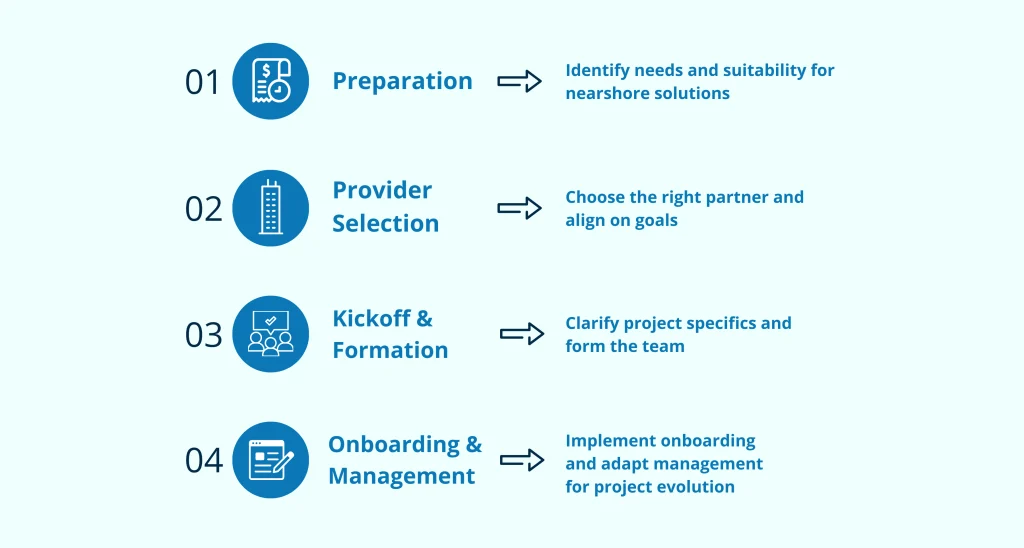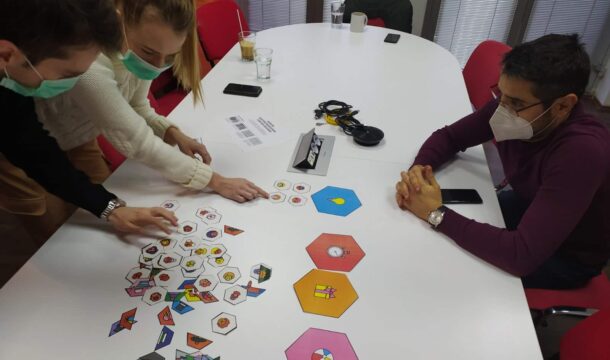Expanding your software development capabilities is often vital for growth. For many startups and scale-ups, scaling quickly and managing costs is difficult. A nearshore development team is a potential solution to tackle that.
Nearshore software development offers a cost-effective alternative to local talent sourcing. Plus, it brings enough cultural and operational matching that’s harder to find in outsourcing models such as offshoring.
Yet, making this model work for your business comes with its challenges.
When does it make sense as a decision? What are the actions for a successful integration?
Based on hands-on experience and client feedback, we’re here to guide you through the process.
Specifically, we cover:
- Preparation and Strategy: Identifying your project needs and why a nearshore solution potentially fits.
- Provider Selection and Introductory Meeting: Choosing the right business partner and having an introductory meeting to ensure mutual understanding and compatibility in approach.
- Kickoff and Team Formation: Having a detailed kickoff meeting to clarify specifics and assemble the team based on those requirements.
- Team Onboarding and Adaptive Management: Integrating nearshore software development teams with an onboarding process and adaptive management practices for ongoing collaboration and project evolution.

1. Define Your Requirements Clearly and Timely
Are you updating an old system, developing functionalities, or requiring specialized DevOps support? Do you have a rough time frame for delivery? Have you considered how this aligns with your capacity and workflows? Identifying what you need initially helps tailor your approach to effective scaling.
With that in mind, it is wise to begin planning before the need becomes urgent. Many companies think about expansion after experiencing growth or securing funding, which can lead to rushed decisions or misaligned hires.
Plus, the local talent market is challenging—you probably already know this. A 2022 CBI report notes that the demand in Europe for IT services often exceeds the local supply. In turn, this makes nearshore software outsourcing a viable option. As a model, it gives you access to broader talent pools with the necessary skills, cost-effectiveness and a better cultural fit for long-term growth.
However, we recommend considering nearshoring as a strategic move, not just a quick fix. View it as an investment in a partnership that grows with your business, providing the flexibility to scale operations in sync with your project lifecycle and broader objectives.
Moreover, having a clear enough idea of your demands can improve discussions with potential providers of nearshore software services. Even a rough understanding is a great starting point and can lead to more suitable proposals.
2. Choose the Right Nearshore Development Company
Selecting the right provider starts with the basics—track record, technical expertise, and client reviews. Evaluating these parameters will give you a view into their capabilities and reliability:
- Assess Track Record and Technical Expertise: Look for past projects and outcomes to gauge their reliability and technical proficiency.
- Check Client Reviews and Testimonials: Testimonials provide a window into the experiences of past clients, offering valuable insights into the provider’s service quality.
Additionally, ensure the company can handle contracting and compliance according to your region’s legal standards and operates in the same or similar time zone for smoother synching and communication.
Still, one critical element often overlooked is how well a provider’s business ethos and operational practices match your own.
Considering that, we encourage you to:
- Ask About Processes and Challenges: In the introductory meeting, ask about their process management, communication practices, and approach to solving challenges.
- Evaluate Flexibility and Transparency: Opt for a provider that demonstrates flexibility in their service offerings and transparency in their commitments. Steer clear of companies that promise immediately available nearshore teams as it might indicate a compromise on quality. Quality software professionals are rarely on the bench.
Lastly, don’t overlook the power of your professional network. Engaging with peers who have experienced nearshoring or similar approaches firsthand can provide you with unfiltered information and help set realistic expectations. We encourage tapping into this resource; many of our satisfied clients expressed their openness to sharing their experiences with interested parties.
3. Start Vetting and Forming Your Nearshore Development Team
By now, you’ve likely chosen a nearshore partner from a list of candidates or followed a strong referral. Ideally, the introductory meeting has set the stage, and both parties want to proceed.
Next, we come to a critical phase: the kickoff meeting. Specifically, this refers to the pre-formation phase of the nearshore team. At Xessable, we view this step as foundational, not just procedural.
The goal? To confirm both sides are on the same page regarding the project’s scope and sourcing expectations.
Kickoff Meeting and Pre-Formation Phase
We kickstart with an in-depth discussion to fully grasp the project’s technical scope and finer details.
For instance, we had a client who initially requested full-stack capabilities. But, with closer examination, the project was primarily for internal use and didn’t require elaborate front-end features. So, we realized a backend-focused engineer would be more fitting. Such an adjustment saved them resources and ensured the talent was fully engaged and productive.
Post-Kickoff Meeting Actions and Team Formation
Now, let’s outline the actions taken after the kickoff meeting to assemble your dedicated professionals efficiently:
- Market Scanning: We conduct a pre-scan market report to assess available talent and current trends, ensuring our search is targeted and efficient.
- Recruitment Strategy: We advertise the position and start the search to attract candidates with the right skills and a strong cultural fit.
- Thorough Assessments: Candidates undergo proper technical and personal assessments through HR and technical interviews.
- Providing Candidate Profiles: You receive detailed profiles of potential hires, including CVs and assessment results, helping you make informed decisions.
- Client Interviews: At this final stage, we bring together you, the client, and the candidate. Our role is to facilitate the interview. In addition, we provide feedback and assist in negotiating employment conditions to finalize the match effectively.

During this phase, we offer consultation points about each candidate’s strengths and areas for growth, helping you understand their potential impact on your project.
While we understand the need to fill positions fast, realistic timelines are crucial. Quality candidates often have commitments that require notice periods. So, immediate availability could be a red flag, suggesting the candidates may not meet the necessary standards.
4. Onboard and Manage the Nearshore Development Team
Once you form the team, the necessary phase of onboarding and integration begins. Here’s how you can approach this process:
- Structured Onboarding: Initiate the integration with an onboarding session led by knowledgeable personnel such as a Project Manager or Product Owner. They can be instrumental in clearly communicating project goals and technical requirements to the entire team.
- Communication and Task Management Tools: Use platforms for real-time collaboration and task visibility to establish clear communication on project timelines and responsibilities. We encourage clients to use their preferred systems to avoid disrupting existing workflows.
- Adopt Agile Practices: Employ agile methodologies to adapt quickly to project changes and incorporate ongoing team feedback effectively.
- Promote a Feedback-Friendly Environment: Establish a culture where all team members are encouraged to share insights and suggestions, improving collective problem-solving.
- Conduct Regular Sync Sessions: Hold frequent meetings to align the team with evolving project goals and make necessary adjustments.
Effective Onboarding and Employee Care
As a provider, we have a thorough onboarding process that covers everything from technical setups to detailed job role descriptions. Plus, we manage all aspects of employee welfare—such as health benefits, professional development, and work environment—so our clients can focus on the project rather than administrative concerns.
Custom Team Configurations for Optimal Outcomes
Our approach to structuring teams is flexible. We’ve designed it to match the specific demands of each client initiative. Specifically, we can assemble a team focused entirely on extension tasks or blend it with your in-house core capacity. Naturally, projects evolve and their demands change. With adaptive management practices, we’re also continuously ready to scale your nearshore development team promptly and accordingly.
Take, for example, a past client we had in the hospitality industry. The task at hand was developing a sophisticated online booking system. Starting with just two specialists focused on side integrations, we saw one team member advance from a junior role to leading significant aspects of the project. The progression highlights the adaptability of our team setups, which led to client success and growth opportunities for our staff.
Final Thoughts
Throughout this guide, we’ve outlined key steps to successfully setting up a nearshore development team.
Here’s what we’ve covered:
- Preparation: Identify needs and suitability for nearshore solutions.
- Provider Selection: Choose the right partner and align on goals.
- Kickoff and Formation: Clarify project specifics and form the team.
- Onboarding and Management: Implement onboarding and adapt management for project evolution.
Frankly, the process is not a silver bullet. However, by choosing it as an approach, you’ll be able to:
- Focus on your business core better
- Improve backlog clearance
- Scale operations smoother
Nearshore development provides a strategic advantage, balancing cost with capability without the heavy overhead associated with local options.
If you’re interested in exploring more, we provide a free consultation. Don’t hesitate to reach out in the brief form below for an open and productive discussion.



